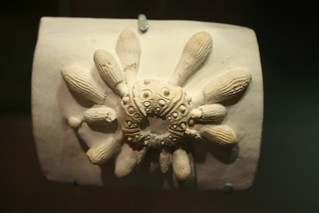 |
| Tylocidaris clavigera from the Cretaceous of England Stunning image from the BMNH Echinoid Page. here |
Most of these taxa are either cidaroid sea urchins or closely related to them. Cidaroids are considered a "stem group" among sea urchins. That is to say, they arise early in the evolutionary history of the group. They have a different jaw apparatus and vary in several other respects. Including the unusual absence of an epidermis from the spines, which permits growth of various other organisms on the surface. I've written about this here.
Cidaroids may also be very important in understanding deep-sea dynamics and the historical ecology of other echinoderms, such as crinoids (feather stars). See that article here. They have been around for quite awhile.. and have been known since the Paleozoic..
But some of the CRAZIEST urchins occur from the Mesozoic, that is during the time best known for the dinosaurs. Oceans were widespread during this time
One of these neat urchins is the Mesozoic (Jurassic to the Cretaceous) to recent cidaroid urchin, Tylocidaris.
Tylocidaris appears to have MASSIVE, club-shaped spines which were presumably used for defense..
 |
| Image of a cast by Ryan Somma |
MUCH thanks for the images from this Danish gentleman's excellent page about fossil sea urchins!
These spines are from a Cretaceous Tylocidaris sp.
 |
| Image by Søren Bo Andersen fr. his website |
 |
| Image by Søren Bo Andersen fr. his website |
 |
| Image by Søren Bo Andersen fr. his website |
Psychocidaris oshimai..

Curiously, the spines seem to be made up primarily of this weird cortex like covering...
|
 |
SIMILAR URCHINS...
the Jurassic Pseudocidaris mamossa Big CLUB like spines!
 |
| Image by Fernando Bravo |
And just in case you thought only fossil urchins could have all the fun! here' an assortment of neat urchins that are alive TODAY which bear bizarrely shaped spines...
Goniocidaris sp. from the South Pacific. (MNHN Paris collection)
A second Goniocidaris species.. with very different spine patterns..
Morphology-seemingly simple and straightforward... and yet, what do the animals use them for?




No comments:
Post a Comment